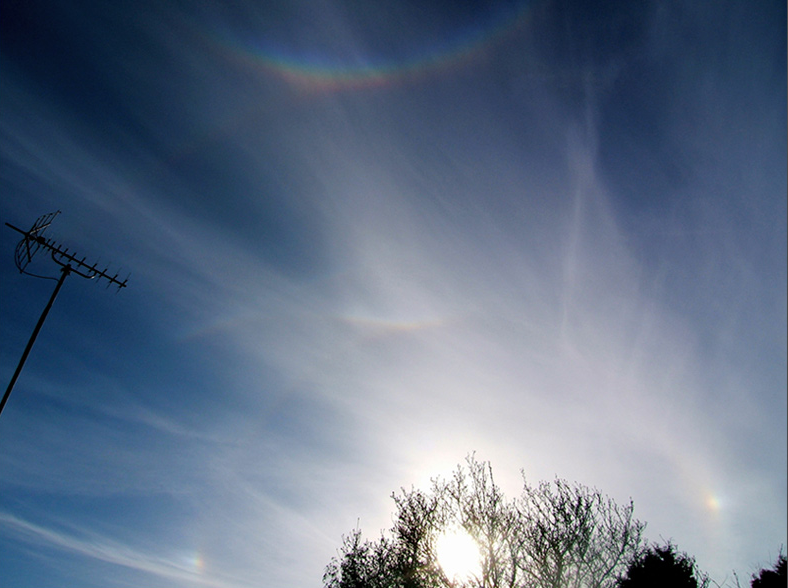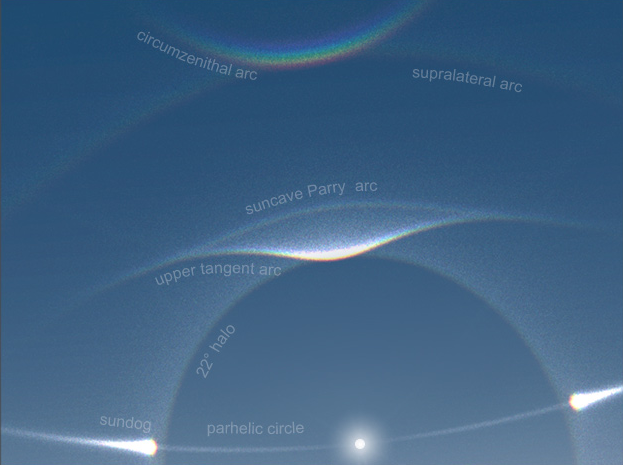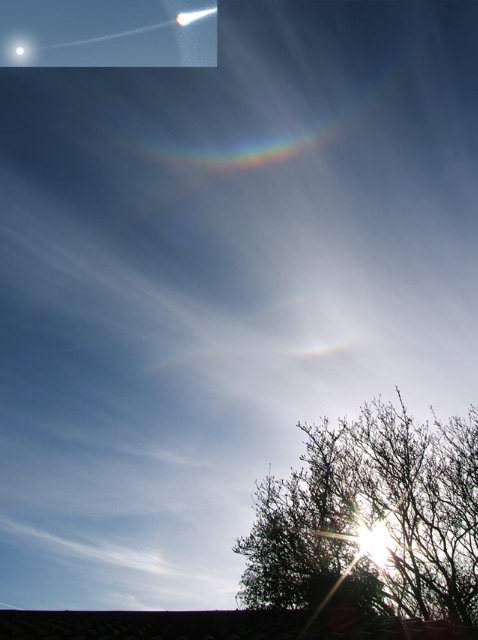First Cuckoo of Spring?
The Marvelous Display of Atmospheric Optics in Kent
On the afternoon of March 16th, the skies over Kent in the Southeast of England put on a stunning display of atmospheric optics. Honor Wheeler, a resident of Kent, was fortunate enough to witness and capture this extraordinary phenomenon. Normally, halo displays in this region are not very complex, but on this particular day, the conditions were just right, resulting in a mesmerizing spectacle.
The photographs taken by Wheeler showcase a variety of optical phenomena. Sundogs, a partial 22-degree halo, an upper tangent arc, a Parry arc, a circumzenithal arc, and a partial supralateral arc were all present in the display. Wheeler mentions that she had photographed each of these phenomena separately before, but never all together in one display. The entire spectacle lasted approximately 20 minutes, with the circumzenithal arc being the longest-lasting feature.
To understand the scientific explanation behind this captivating display, let's turn to HaloSim, a ray tracing simulation tool. In the simulation matching the observed conditions, the sun was set at an angle of 21 degrees above the horizon. Different types of ice crystals played a role in creating each optical phenomenon. Randomly oriented crystals accounted for the weak 22-degree halo, columns contributed to the upper tangent arc, and hexagonal plates were responsible for the sundogs and circumzenithal arc. The Parry arc, characterized by its finely etched appearance, required a small percentage of peculiarly oriented crystals.
If you're interested in exploring this phenomenon further, you can download the simulation file called "kent.sim" and run it using HaloSim.
It's worth noting that this article has been automatically converted from the old site and may not appear exactly as intended. However, the captivating photographs and detailed explanation provided by Honor Wheeler offer a unique glimpse into the beauty and complexity of atmospheric optics.
This display over Kent serves as a reminder of the diverse and fascinating optical phenomena that can occur in our atmosphere. Here are some key takeaways from this extraordinary event:
- Atmospheric optics refers to the study of how light interacts with the Earth's atmosphere, resulting in various optical phenomena.
- Halo displays are a common type of atmospheric optics phenomenon that occur when sunlight interacts with ice crystals suspended in the atmosphere.
- Sundogs, also known as parhelia, are bright spots that appear on either side of the sun. They are caused by the refraction of sunlight through ice crystals.
- A 22-degree halo is a circular ring of light that forms around the sun or moon. It is caused by the refraction and reflection of light within ice crystals.
- An upper tangent arc is a bright arc of light that appears tangent to the top of a 22-degree halo. It is formed by the refraction of light through horizontally oriented ice crystals.
- A circumzenithal arc is an arc of light that appears above the zenith. It is caused by the refraction of sunlight through horizontally oriented ice crystals.
- The Parry arc is a faint, finely etched arc that forms inside the 22-degree halo. It is created by the refraction and reflection of light within peculiarly oriented ice crystals.
- A supralateral arc is a partial arc of light that appears above the 22-degree halo. It is formed by the refraction and reflection of light within horizontally oriented ice crystals.
In conclusion, the first cuckoo of spring brought with it a breathtaking display of atmospheric optics in Kent. Honor Wheeler's photographs captured the beauty and complexity of this phenomenon, showcasing sundogs, a partial 22-degree halo, an upper tangent arc, a Parry arc, a circumzenithal arc, and a partial supralateral arc. The HaloSim ray tracing simulation provided further insights into the scientific explanation behind these optical phenomena. This event serves as a reminder of the marvels that can occur in our atmosphere, captivating us with their ethereal beauty.

England Skies ~ Halos over Kent on the afternoon of 16th March. Captured by Honor Wheeler. ©Honor Wheeler.

"I live in Kent, in the Southeast of England and so don't usually expect complexity in a halo display as the conditions are never quit right. Today, however, I was amazed and excited to photograph sundogs, a partial 22deg halo, an upper tangent arc, a Parry arc, circumzenithal arc and a partial supralateral arc. I've photographed all but the supralateral arc separately before but never all together! These photos were taken between 15.34 and 15.41UT but overall the display lasted for approx 20 minutes with the circumzenithal arc lasting the longest."
In the matching HaloSim ray tracing simulation. The sun was set to 21° high. 32% random oriented crystals produced the weak 22° halo, 35% columns made the upper tangent arc and 30% hexagonal plates the sundogs and circumzenithal arc. The finely etched Parry arc needed only 3% of its peculiarly oriented crystals.
If you have HaloSim installed, run the simulation yourself after downloading the simulation file kent.sim

Note: this article has been automatically converted from the old site and may not appear as intended. You can find the original article here.
Reference Atmospheric Optics
If you use any of the definitions, information, or data presented on Atmospheric Optics, please copy the link or reference below to properly credit us as the reference source. Thank you!
-
<a href="https://atoptics.co.uk/blog/first-cuckoo-of-spring/">First Cuckoo of Spring?</a>
-
"First Cuckoo of Spring?". Atmospheric Optics. Accessed on April 20, 2024. https://atoptics.co.uk/blog/first-cuckoo-of-spring/.
-
"First Cuckoo of Spring?". Atmospheric Optics, https://atoptics.co.uk/blog/first-cuckoo-of-spring/. Accessed 20 April, 2024
-
First Cuckoo of Spring?. Atmospheric Optics. Retrieved from https://atoptics.co.uk/blog/first-cuckoo-of-spring/.